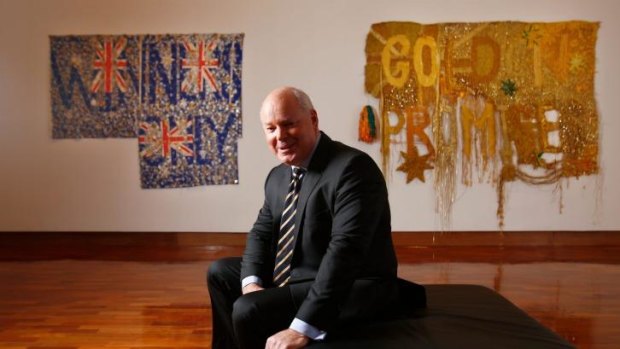This was published 9 years ago
Vaughan steps into series of challenges at National Gallery of Australia
Gerard Vaughan will have to hit the ground running when he takes up his three-year term as National Gallery of Australia director in November.
The former National Gallery of Victoria director and University of Melbourne art historian will confront several immediate challenges when he begins work at the Canberra gallery on November 10.

Enthusiastic: Newly appointed National Gallery of Australia director Gerard Vaughan, at the Ian Potter Museum of Art at Melbourne University. He is seated in front of Wealth for toil I and II by Raquel Ormella.Credit: Eddie Jim
Before Vaughan has even begun the role, NGA council chairman Allan Myers (with whom Vaughan worked at the NGV, where Myers was president) has identified three main challenges Vaughan will be expected to address: those include dealing with the after-effects of the stolen antiquities scandal, overseeing the second stage of the gallery's expansion and dealing with a reduced budget for the gallery.
Vaughan makes no bones about the fact that the role presents some major challenges, but also huge opportunities.
"I'm really pleased about it," he said in an interview with Fairfax Media after his appointment was officially announced by Federal Arts Minister Senator George Brandis on Thursday.
"From my perspective, having been director of the NGV for 13 years, the opportunity to make a significant contribution at is national level is a real challenge.
"In many ways, I think that a national institution has a more clearly focused and defined national role."
That role includes what Vaughan calls "cultural diplomacy", which reflects Australia's place in the world, a focus on the art and artefacts of countries in the Asia-Pacific region and promoting our artists overseas.
Many of Vaughan's ideas in this area were informed by the time he spent working at the British Museum, where he spent seven years as director of the institution's Development Trust before returning to Australia in 1999 to run the NGV.
"I am a great believer in cultural diplomacy," Vaughan said.
"For me it's very much about being active both collecting the visual culture of our own region, whether that's in the Pacific - Cambodia, Indonesia, Thailand - and the culture of East Asia - China and Japan."
Such positioning could also help address the fallout from the scandal over stolen antiquities that has plagued the NGA and tarnished the reputation of the institution and its recently retired director, Ron Radford.
During Radford's directorship, the gallery bought a number of artefacts from now-disgraced Indian antiquities dealer Subhash Kapoor. In 2008 the gallery purchased an 11th century dancing Shiva statue from Kapoor for $5 million. It was later discovered to have been stolen and last month was handed back to the Indian government by Prime Minister Tony Abbott.
The federal government this week released a policy for all Australian collecting institutions containing guidelines about acquisitions, clearly in a bid to avoid any more scandals.
"It's an example of a national [policy], with a lead from Canberra, because the Prime Minister took the dancing Shiva [and] presented it to the indian government, he gave it back, and I just think that puts Australia right at the forefront and very visibly," Vaughan said.
"I think now that just sets a national standard, and everyone's agreed to it: the federal minister and the state ministers for culture, together they signed it off. And my view on it is it's sort of drawn a line across whatever has happened in the past with any museum in the country."
While acknowledging that there had been some issues with Radford's handling of the matter, Vaughan was at pains to make clear that he had great respect for his predecessor, who spent more than a decade running the NGA.
"It's very important for me to say this, that Ron Radford, who has just retired as NGA director, is a truly great director. He's given his entire life to public museum culture in this country. He's done an amazing job and I have the highest respect for him."
In future, part of the NGA's role in the region could include helping countries in the region preserve their own cultural heritage, Vaughan said (a move that could be seen by some as a way of making amends for the Shiva scandal).
"There are cultural diplomacy opportunities, [such as] for Aust to represent the cultures of other countries ... with the NGA playing a central role, given its hugely important Pacific art [collection].
"I think getting the culture of our near neighbours out there is a really important thing to do. The other side of that coin is what can we do to help other countries in terms of looking after their cultural heritage.
"There may be ways Australia can achieve things in these areas."
Showcasing works from the Pacific region is a "big part" of the second stage of the museum's redevelopment (stage one included the The Centre for Australian Art and the newly opened NGA Contemporary wing).
"There's not enough room at the moment," Vaughan said of Pacific art. "That's a big part of stage two."
Promoting Australian art overseas, such as through exhibitions like last year's Australia showcase at London's Royal Academy, which was co-curated by the NGA, was easier to achieve from Canberra, as was bringing major international exhibitions here, Vaughan said.
"It's where … national embassies are. When anyone is planning exhibitions, certainly the ambassadors and staff of the embassies are a very important part of making progress.
"I'd love to see more of that, sending Australian art around the world."
With Natasha Rudra